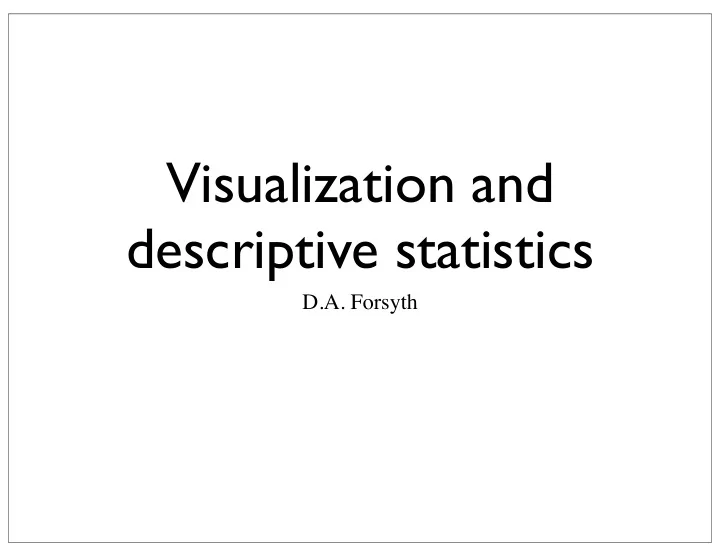

Visualization and descriptive statistics D.A. Forsyth
What’s going on here? • Most important, most creative scientific question • Getting answers • Make helpful pictures and look at them • Compute numbers in support of making pictures • Data has types • Continuous • Discrete • Ordinal (can be ordered) • Categorical (no natural order, “cat” vs “hat”) • Different plots apply
Histograms Categorical data Ick!
Bar Charts Categorical data - counts in category
Histograms Ick! Continuous data
Histograms
Conditional Histograms
Data example • Clicks, impressions and ages for NYT website • https://github.com/oreillymedia/doing_data_science • Question: Look at data - what’s going on? • Example R code on webpage
Why R? • It’s free • It’s easy to get pictures up and going • from weirdly formatted datasets • Many, many tools • most of the code I’ll work with is downloaded/copied • that’s the right strategy • work with tools *without* implementing them
Some R setwd('/users/daf/Current/courses/BigData/Examples') data1<-read.csv('/users/daf/Current/courses/BigData/doing_data_science-master/dds_datasets/dds_ch2_nyt/nyt1.csv') data1$agecat<-cut(data1$Age, c(-Inf, 0, 18, 24, 34, 44, 54, 64, 74, 84, Inf)) # This breaks the Age column into categories data1$impcat<-cut(data1$Impressions, c(-Inf, 0, 1, 2, 3, 4, 5, Inf)) # This breaks the impression column into categories summary(data1)
Age Gender Impressions Clicks Signed_In agecat impcat Min. : 0.00 Min. :0.000 Min. : 0.000 Min. :0.00000 Min. :0.0000 (-Inf,0]:137106 (-Inf,0]: 3066 1st Qu.: 0.00 1st Qu.:0.000 1st Qu.: 3.000 1st Qu.:0.00000 1st Qu.:0.0000 (34,44] : 70860 (0,1] : 15483 Median : 31.00 Median :0.000 Median : 5.000 Median :0.00000 Median :1.0000 (44,54] : 64288 (1,2] : 38433 Mean : 29.48 Mean :0.367 Mean : 5.007 Mean :0.09259 Mean :0.7009 (24,34] : 58174 (2,3] : 64121 3rd Qu.: 48.00 3rd Qu.:1.000 3rd Qu.: 6.000 3rd Qu.:0.00000 3rd Qu.:1.0000 (54,64] : 44738 (3,4] : 80303 Max. :108.00 Max. :1.000 Max. :20.000 Max. :4.00000 Max. :1.0000 (18,24] : 35270 (4,5] : 80477 (Other) : 48005 (5, Inf]:176558
Users by age
Impression histogram, faceted by age
Click histogram, faceted by age
Click/Impression histogram, faceted by age
2D Data
Categorical data Pie charts are deprecated - it’s hard to judge area by eye accurately
Mosaic Plots
The UFO data set http://www.infochimps.com/datasets/60000-documented-ufo-sightings-with-text-descriptions-and-metada • UFO sighting data • date of sighting; date of report; location; description; some free text • rather messy data • about 15 years of sightings (‘95 - ’08 with some others) • broke into 1000 day blocks • looked at most common shape descriptors • (' disk', ' light', ' circle', ' triangle', ' sphere', ' oval', ' other', ' unknown') • great example of categorical data • R-code on website • not great code, but informative • building a map, merging datasets, reading datasets, mosaic plots • you should look at this
Conclusion: UFO shapes haven’t changed over time
Ordinal data
Ordinal data
Series
Scatter plots • Plot a marker at a location where there is a datapoint • Simplest case - geographic
Arsenic in well water
UFO sightings by state
UFO’s by interval
UFO’s by interval
UFO’s by interval
UFO’s by interval
UFO’s by interval
UFO’s by interval
Interesting analogy • Blackett’s reasoning about submarine sightings in WWII • can estimate probability of sightings • lead to significantly improved sighting rates, aircraft painting and lighting strategies (see Korner, “The pleasures of counting” or good histories)
NYT data - remarks • Many data points lying on top of each other • scatter plot can be deceptive • jitter the points (move by a small random amount)
Age Gender Impressions Clicks Signed_In agecat impcat Min. : 0.00 Min. :0.000 Min. : 0.000 Min. :0.00000 Min. :0.0000 (-Inf,0]:137106 (-Inf,0]: 3066 1st Qu.: 0.00 1st Qu.:0.000 1st Qu.: 3.000 1st Qu.:0.00000 1st Qu.:0.0000 (34,44] : 70860 (0,1] : 15483 Median : 31.00 Median :0.000 Median : 5.000 Median :0.00000 Median :1.0000 (44,54] : 64288 (1,2] : 38433 Mean : 29.48 Mean :0.367 Mean : 5.007 Mean :0.09259 Mean :0.7009 (24,34] : 58174 (2,3] : 64121 3rd Qu.: 48.00 3rd Qu.:1.000 3rd Qu.: 6.000 3rd Qu.:0.00000 3rd Qu.:1.0000 (54,64] : 44738 (3,4] : 80303 Max. :108.00 Max. :1.000 Max. :20.000 Max. :4.00000 Max. :1.0000 (18,24] : 35270 (4,5] : 80477 (Other) : 48005 (5, Inf]:176558
NYT scatters
Scale is an issue
Outliers can set scale
But scale is really a problem
Lynx pelts
Data example • Housing sales in NYC boroughs • https://github.com/oreillymedia/doing_data_science • Question: Look at real estate sales - what’s going on?
Summary Statistics - mean The average The best estimate of the value of a new datapoint in the absence of any other information about it
Summary statistics - Standard deviation Think of this as a scale Average distance from mean Important math properties in notes
Standard deviation = there are not many points many standard deviations away from the mean = there is at least one point at least one standard deviation away from the mean
Standard coordinates
Suppressing scale effects • Do scatter plots in standard coordinates for x, y
Lynx, normalized
x, y don’t really matter
Positive Correlation
Zero Correlation
Negative correlation
The Correlation Coefficient
Correlation isn’t causality and foot size is positively correlated with reading ability, etc.
but can be used to predict
NYT normalized • What’s going wrong here?
A Mosaic Plot
Recommend
More recommend